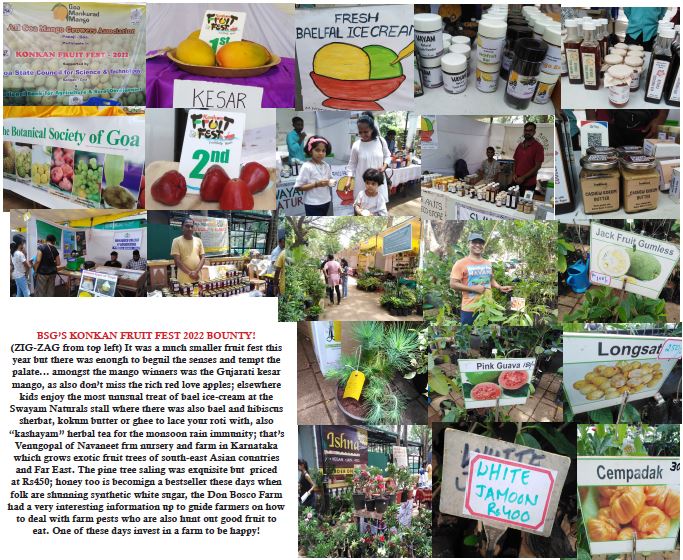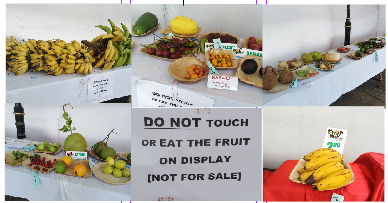By Tara Narayan
HEY, the Botanical Society of Goa’s summertime Konkan fruit festival is the festival of all festivals in Goa. There have been some grand spreads of this festival in the past but the present one was more frugal – therefore, I guess it was a smaller fruit fest this year. Consider that it was returning after three years of with all the corona virus pandemic and lockdown scares and restrictions…usually when this fruit festival is in town Panaji I cannot resist going every day for a while to look and muse over the smorgasbord of tropical fruit growing on Goan farms and neighbouring state farms.
Over the years the BSG has done much to promote the return to farming in Goa and Goa may now take credit for any number of small scale farmers and a few big farmers. This time there were fewer commercial stalls offering this, that and the other, by way of farm produce, and mangoes there were in plenty of course – with the Cardozo mango taking pride of place for it is now competing with the much loved Goan mankurad.
New grafts of the Cardozo mango are available and Nestor is playing a key role in reviving this mango breed (you may get grafted saplings from him). The Cardozo is excellent and I would say almost on par with the Devgad alphonso, in the sense it is a more of a table mango and one may cut and relished draped in whipped fresh malai (milk cream), a traditional combination. But cool all cut mango in fridge first…although of course there are ways and ways of eating mangoes. With spoon or fork or without spoon or fork or just fingers. Mangoes are hyglycemic fruit I assure you, eat less, enjoy more, always think less is more when it comes to mangoes!
The Cardozo were selling at a Rs1,000 dozen but worth it, the smaller variety was going at Rs800 per dozen or so. I often wonder why farms sell their produce at market rate or higher! Surely, the overheads are lower for farm produce? But then I hear the stall rentals at the Konkan Fruit Fest 2022 were as high as Rs2,000 per day!
The usual plant nurseries were there offering their range of plants and succulents, a jade plant attracted me but I was not buying at Rs550 per plastic pot. With so much green consciousness around nowadays many folk are building up their collection of plants and I hear some of them even rent out plant pots for events and occasions and parties. Mostly ornamental plants like hibiscus or bougainvillea or roses and even ornamental palms of which there are many, Plants are no longer cheap to buy (except at the government nurseries).
Private nurseries have become a most lucrative business to invest in with even ordinary pots of ornamental crotons priced at Rs150 plus, plus. Mulberry plants I notice were much in demand, both the purple back and lovely green variety. Even tulsi nobody gives away free nowadays! This is to say on all three days I saw a frenetic sale of plants both ornamental and fruit-bearing going on …both ornamental, but also of the Konkan fruit trees.
AND there were the exotic fruit plants from South East Asia featuring mangosteen, rambutan, langsat, Daeng Suria is a kind of reddish jackfruit, cempadak, and there’s a Jack Vietnam Super Early which reportedly bears fruit at ground level and it ripens before the other jacks do. There’s even a jackfruit gumless…a Venugopal of Navaneet Farm Nursery here told me he has got the king of all Asian fruit – the gorgeous durian – growing on his farm. Wait till it comes into fruit and then he will call me!
You must know the thorny olive-coloured durian can fill an entire home with its potent scent (I will never call it odour). It’s the much loved fruit of the Cambodian states, in Thailand, Malaysia, Singapore and Indonesia where I have eaten lots of durians in my teenage years – on durian picnics on durian farms and first we eat durian, then mangosteen and finally rambutan to cleanse the mouth of durian aroma or odour (whichever you wish). Durians you may love or hate unabashedly.
Jackfruit, I think come a close second to durian and these days I’m terribly taken up with jackfruit and jackfruit seeds which I find myself soaking in water for a few days, then the outer scaly skins come off and I pressure cook the seeds with pinch sea salt. What emerges is cooked jackfruit seeds swirling in a pink soup (by all means use as soup if you wish, has a nice aroma). The cooked seeds you may serve as a snack or garnish pulao and salad with. The jackfruit has become as iconic as the coconut tree and other palms in Kerala and Karnataka …the jackfruit tree offers so many gifts that it is almost an industry now. It’s a most interesting tree, yes, another one of our kalpavriksha or wish-fulfilling trees of our tropical landscapes, even in Goa.

IT’S always a high point of the festival to take in the competition entry displays but this year they were a very tightly protected affair with visitors kept at a distance by a thick rope and scores of notices up telling all voyeurs to be content to only look and not touch. Admire from far. Well, so I couldn’t quickly and surreptitiously and sometimes spontaneously pop one of the delicious mulberries or a glossy magenta love apple or Indian cherry (Carissa carandas) in my mouth!
I consider karvanda akin to British cranberries and you must know in general all kinds of edible wild berries have health-giving medicinal values by way of let food be your medicine. I have it on good account that berries and especially strawberries and blueberries are good for cardio-vascular problems, eat more berries if your arteries, veins and capillaries are hardening with atherosclerosis for want of nitric oxide production (nitric oxide production in body beautiful is the indicator chemical or something like which reveals the status of our health).
Then on display were the fascinating love apples in varying colors ranging from ivory green to ruby reds… heard about velvet apple (Diospyros blancoi) or lakoocha (Artocarpus lakoocha)…ooooh, the chirput (Physallis peruviana) are a favourite with me although so hard to find, and the oh so cooling to look at gooseberries (Phylanthus acidus)…then noni fruit (Morinda citriatus) and much, much more to look at and marvel about. The world of fruit is fantabulus and can keep one enthralled for hours.
Star attractions were the prizewinning mangoes like the Goan mankurad, Cardozo, Goan alphonso and the totapuri, pairi, kesar (the Gujarati kesar competes with the alphonso as a premium table fruit for cutting purposes, no fibre, too much fibre is as bad as too little fibre it seems). Do you know there’s a San Thome Museum in Goa and it is dedicated to the San Thome mango variety. So named after Thomas Antonio da Costa in Varca who has this mango tree which is now 80 years old and much cheraished. Applesta D’Costa here at the festival said her dad Thomas is now 86 years old and their mango tree is one of a kind…it was planted with seed and is not a graft (although they are now making grafts for sale).
What does the San Thome mango taste like? I asked her (for there were none on display or for tasting) and she replied, “It’s a mango which tastes of cinnamon, has a spicy flavour.” Her father would like to save this mango variety for mango lovers of whom there are many in Goa. Hey, one of these days I must go see this San Thome mango tree, sounds exciting.
Then I discovered a new range of honey coming into the market and a Prashant Sawant told me, “Some of this honey I have is multi-flora and comes from the Assam-Bhurma collection….for 500 g it costs Rs8,50,000 or less, may be Rs18, 450!” Not joking. Is there anything more affordable? I asked, and he made me taste tulsi and ajwain and jamun honey so divine, how much? Rs150 per 100 gm bottle. Sorry, by the time I discovered the honey I’d run out of cash in my handbag and had to say goodbye to it with some regret. Interesting man, this Prashant Sawant though, must catch up with him some time! He is full of honey lore and honey’s magical medicinal properties…but who doesn’t know this. If I were you I would chuck refined sugar pronto and get some real honey, no matter how expensive (only for crorepati connoisseurs of honey)!
LIKE I said it before the BSG’s Konkan Fruit Festival is always such a treat for the senses and palate — food for the mind and body, heart and soul. Two people I sorely missed this year were Dr Ajit Shirodkar with his Devgad alphonso, pairi and kesar mangoes (is he exporting all of them now?) and I will always miss the timeless evergreen farmer Srihari who used to come for the Konkan Fruit Fest with kokum to give away almost for free, and coconut oil, turmeric, always some more interesting stuff like a kashaya herbal tea. How are you Srihari bab?
